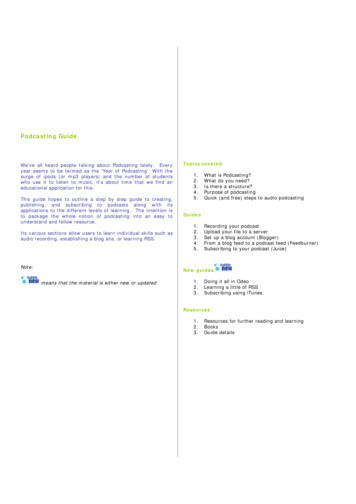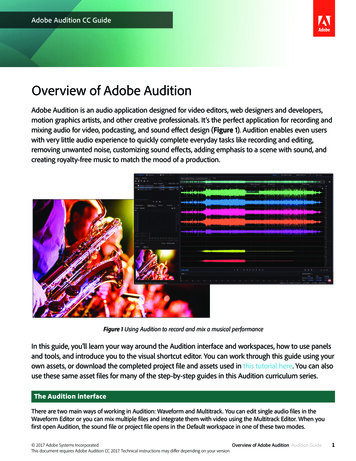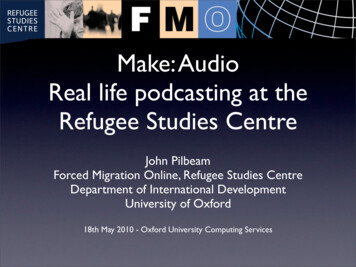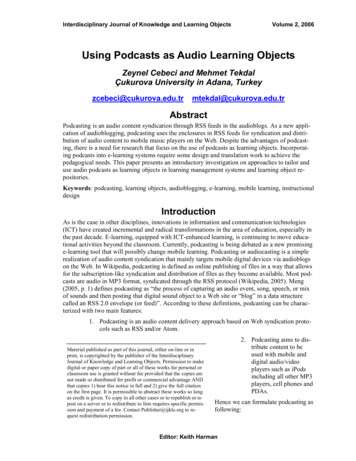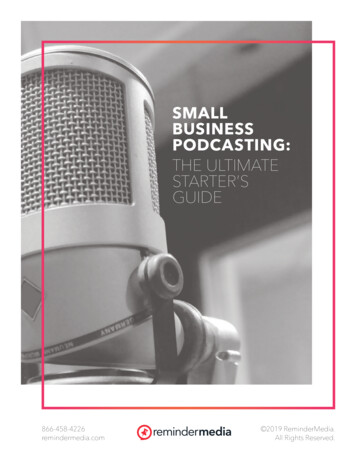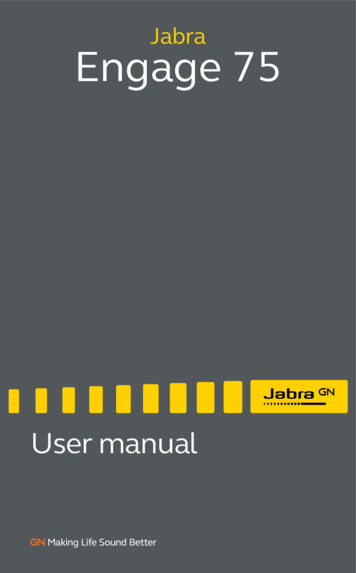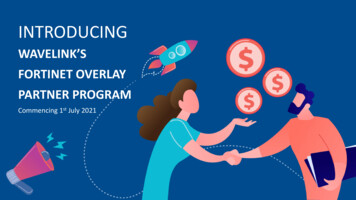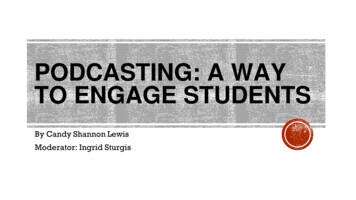
Transcription
PODCASTING: A WAYTO ENGAGE STUDENTSBy Candy Shannon LewisModerator: Ingrid Sturgis
What is podcasting?A digital audio program that a listenercan download from the internet andlisten at a time that suits the listener.
Podcasting Industry Today Podcasting is expected to produce more than 1 billionin revenue by 2021. Estimated 88 million podcast listeners in 2019, withgrowth projected to more than 160 million by 2023.
Podcasting Industry Today Growth has accelerated as the number of major distributorshas grown, including iTunes, Soundcloud, Spotify, Stitcher,Google Play Music, TuneIn, iHeartRadio and more. Gimlet Media distributes one of my favorites, Uncivil. It is aPeabody Award winner and no longer in production.
Podcasting and the Student DemographicPodcast listenershiphas grownexponentiallyamong AfricanAmericans andHispanics in 12- to34-year-old
Podcasts by African-Americans Has grown far beyond the number of Black-owned radio stations. Possible because the digital revolution Internet removed the traditional gatekeepers in “legacy” media.
Who can create a podcast? Anyone can create a podcast and upload it to the Internet. Social media is the No. 1 source of marketing and promotion for podcasters. Mobile phones are the No. 1 source for digital media listenership among the12 – 34 age group.
“Students like reading andsimultaneously listening topodcasts even more.”Michael Godsey, English teacher
HOW TOCREATE APODCAST.
DETERMINE YOURCONTENT AND FOCUS.
Podcast and pedagogyEducators K-12 through University have incorporated podcastsinto their teaching. Student assignments designed to provide an assessment oflearning objectives Curated selections from professors to provide information in a fun& entertaining way Student-driven and -created group assignments,
Determine your content and focus Record classroom expectations at the beginning of the year. Give yourstudents a personal welcome in an audio format instead, laying out what toexpect and offering some tips for success on the first day. Classroom lectures. Bring recording tools with you to class or review yourlecture in your office to offer students who might have missed class a chanceto hear your lecture in audio format. This can also be a great record foryourself from semester to semester. Example Intro to Digital Media students explore the role emerging media areplaying in the lives of college students. Groups of about 3 to develop a setof questions about media experiences, interview students from outsideclass, and put it together as an edited audio file with narration.
Determine your content and focus Supplemental information. Use short podcasts as a way to touch on thissupplemental information that’s outside of the core content of the class butstill of interest.
Determine your content and focus Record classroom discussions. Recording these for yourself can help youto hone your facilitation of these talks and ensure that you’re pointingstudents in the right direction each and every semester. XRvLXNwZWFrLWVuZ2xpc2gv?hl en&ved 2ahUKEwjo9v -n-LqAhU gnIEHYQfDc0QjrkEegQIBRAE&ep 6
Determine your content and focus In an English course, students enjoyed listening to contemporarypodcasts in class, and there was value in using the transcripts as primarytexts that allowed students to read along. One class used the podcast fromSerial to help with critical thinking: https://serialpodcast.org/season-oneU
More examples Give new life to an existing assignment. If your course format andcontent permits it, have students build radio broadcasts, digital storybooks,student reviews, and conduct interviews via podcast. Nursing course: Podcast coupled scientific research and data collectionwith a creative and artistic twist to make a project more interesting. Ecology course podcast assignment outcomes: Expose students toecological stories in the news, link these stories to ecological content asdelivered during lectures, to communicate (orally, and as a group) thestory and the ecological concepts linked to the story. Testing review sessions. Share teaching advice with other educators.
GET THE EQUIPMENTYOU NEEDThink mobile
Mac or PC, Android or iPhone
BASIC SETUP: LAPTOP, MIKE,HEADPHONES
Digital recorderZoom H1n 2track portablerecorder –119.002. Zoom H6 6input/6-trackportablerecorder 299.003. Tascam DR-052-input/2-trackrecorder – 89.994. Tascam DR40X 4channel/4-trackrecorder 179.00.
Plug and Play MicrophonesAntelope EdgeGo Bus-PoweredFPGA FXModelingMicrophone.About 1,300.Blue SnowballUSB condensermic. About 70.NeatMicrophonesWidget CDesktop USBmicrophoneAbout 40.Shopping: B&H, Adorama, Amazon, Broadcast SupplyRodeSmartLavLavaliercondensermicrophonefor smartphones.About 80.
HeadphonesGood headphoneshelp cut downbackground noisewhile providingplenty of volume inthe studio or in thefield.Beyerdynamic DT 240 Pro, About 80Sony, about 100
Editing Software.Audacity is afree andopen-sourceaudio editor.FreeGarageband is preinstalled on mostApple computers.Free on Mac.Adobe Audition ispart of the AdobeCreative Suite.Works on anycomputer. About 30a month for entire
WRITE THE SCRIPT.
Writing the Script or OutlineThe script is the podcast, the content. It may include music, sound effects;but those added touches that will not keep a student engaged. The purpose of creating a script is to create a storyline for thepodcast. Any story should have a clear beginning, middle andending to guide the listeners of the podcast. To make the podcastmore interesting to listen to, a strong main question helps toengage the listeners and give them focus. TIP: start your script with raising a question that students findinteresting
RECORD YOURCONTENTPay attention to your voice
Pay attention to your voiceIs your voice inviting? Do you fall into a sing-song pattern? Break it up withpauses, vary your tempo, change the wording.Imagine talking to one person. Audio programs, like radio, can create a moreintimate connection with each person in the audience.
Pay attention to your voice Welcome your listener to the program in the beginning, thank and invite thelistener to return at the end. Repeat the name and topic throughout the program. If you are interviewing a guest or guests, re-introduce during the program;address guests by name some of the time; help the listener distinguishbetween guest voices.
EDIT AND REVIEWPost-production process
Edit and reviewEditing is the post-production part of the podcast –cleaning up mistakes and adding effects and/or music.Editing can: Improve the sound of your voice. Eliminate loud breaths, too many “uhhs”, improvepacing. Balance multiple voices. Add music and other sound effects.
Edit and ReviewConsider creating short podcasts. A program five minutes or less will focus your attentionon what is necessary. A 30-minute presentation can be broken into 6 fiveminute podcasts that promote Parts 2, 3, 4, etc. A 5-minute podcast is a lot easier to edit and upload.
UPLOAD YOUR FILE.
UPLOAD YOUR FILE Finally, when you are satisfied with your podcast product,you will export it as an mp3 file ready for uploading to yourplatform of choice: A cloud service Soundcloud your website. Suggestion: if you are creating a podcast for students, createa link to the podcast so students can go there to listen, insteadof downloading. Echo 360 can be used to store coursepodcasts.
Upload your fileFind a place to host/store your podcasts. This is often separate fromdistributors, which help to promote your podcast:Bluehost – web hostingWordpress – web hostingBuzzsprout – podcast hostingPodbean – podcast hostingPodcastwebsites – podcast hostingSoundcloud is a host and distributor
Distribute your podcastSubmit your podcast to all the top directories. Many people will subscribe topodcasts on these sites so if you’re not there, they won’t find you. The sitesalso act as podcast search engines so people will be able to find you by yourtitle and description.iTunesSoundcloudiTunes / Apple PodcastsSpotifyGoogle PodcastsStitcherTuneIn
FinallyEditing is a skill that will take practice. You mayknow someone who can edit for you and teach.We may be able to help in the Media,Journalism & Film Department.My email: Candy Shannon Lewis:cslewis@howard.edu
ResourcesThe Beginner's Guide to Educational w to make an educational podcast: Tips and tricks for your first educational podcastVanderbuilt University Podcasting Resources (a collection of links)https://library.educause.edu/ ing-a-curriculum-guidefor-educators
ResourcesWhat is a podcast? What differentiates it from radio -podcast/How to be a good podcast voice: rrived?fbclid 0nTRQiZz5w
ResourcesFree pdf book ine.com/?fbclid IwAR30Titt1dH1w22sEGExYU2PcrX2JgS52t KrF2ySq5H8-6QbDwpTHpfh4UPodcast assignment: ring-newmedia-and-college-life/Copyright Info: arights.org/legal how to guides for citizen media creators online publishing
ResourcesWhat is RSS? http://www.whatisrss.com/ , a-podcast/Podcast Equipment: ast/cat2/broadcast podcasting/ci/46431?origSearch gTerm podcasting&searchredirect true
/1026https://kenyon.libguides.com/c.php?g 280050&p ibguides.com/c.php?g 280050&p 2131438
Welcome your listener to the program in the beginning, thank and invite the listener to return at the end. Repeat the name and topic throughout the program. If you are interviewing a guest or guests, re-introduce during the program; address guests by name some of the time; help the listener distinguish between guest voices.
